
Chevrolet Corvettes are legendary sports cars that have riveted the American auto industry since their debut in 1953. With their sleek designs, high-performing engines and non-stop evolution throughout the decades, Corvettes have become a series of coveted automobiles for enthusiasts of all types.
Corvettes are an affordable line of sports cars that are perfect for full restoration projects or minor repairs. Top Flight Automotive has all the parts, accessories, interiors and even wheels to support your projects, no matter if you’re looking to show off a C4 or newer 2017 Corvette.
Jump to:
- Corvette Generation Prices
- C1 Corvette: 1953-1962
- C2 Corvette: 1963-1967
- C3 Corvette: 1968-1982
- C4 Corvette: 1984-1996
- C5 Corvette: 1997-2004
- C6 Corvette: 2005-2013
- C7 Corvette: 2014-2019
- C8 Corvette: 2020
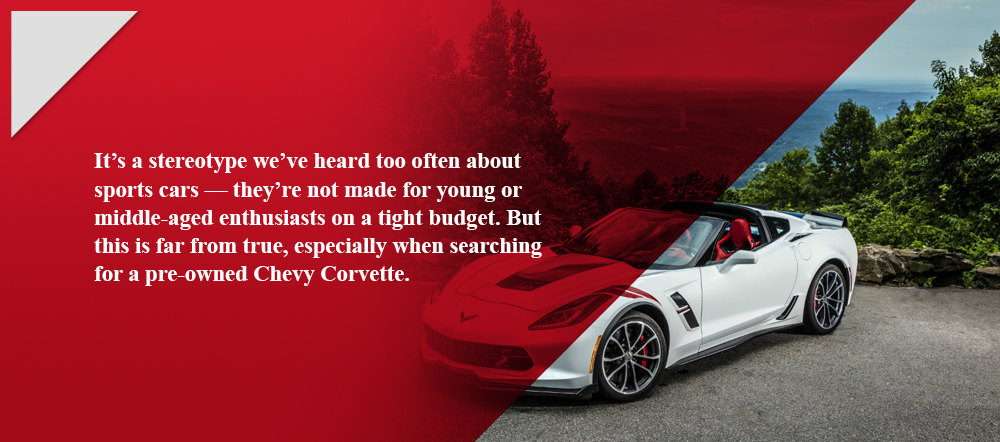
Corvette Generation Prices
It’s a stereotype we’ve heard too often about sports cars — they’re not made for young or middle-aged enthusiasts on a tight budget. But this is far from true, especially when searching for a pre-owned Chevy Corvette. While some generation’s prices are higher than others, many models can be found at a reasonable cost.
The price tag of any Corvette depends on many factors, such as:
- Condition
- Full restoration
- Mileage
- Minor repairs
- Non-Corvette parts
- Original condition
- Rarity
- Restomod
- Specialty model
If you’re searching for low-budget Corvettes, you’ll want to look for models that aren’t rare to come by that have standard features. Some of the cheapest restoration Corvette models are found in the fourth generation, while C1s are among the most expensive.
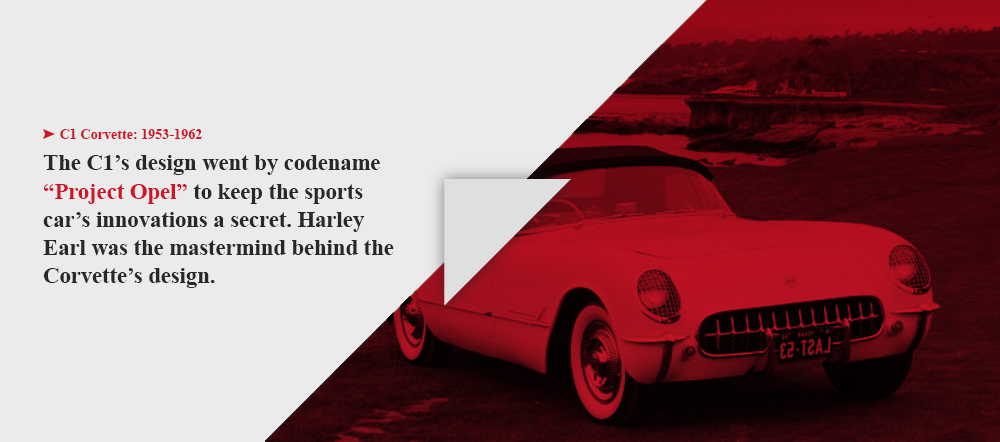
C1 Corvette: 1953-1962
Development plans for the iconic Chevy Corvette began in 1951. It was a time when America started designing its own line of sports cars to go up against its British competitors who were already riding Triumph TR and Jaguar XK 120 automobiles.
The C1’s design went by codename “Project Opel” to keep the sports car’s innovations a secret. Harley Earl was the mastermind behind the Corvette’s design. For two years, he worked on creating the first Corvette concept to show at the General Motors Motorama in NYC. After much success, GM got the go-ahead to start production.
The two-door, two-seat roadster convertible highlighted increased horsepower, superior handling and a better aesthetic than other automobiles at the time. GM saw that consumers were in search of performance and quality, so Earl was in charge of curating the most sought-after American sports cars to hit the pavement.
In 1953, 300 Corvettes came off the production line, having 150 horsepower and a two-speed automatic transmission. It had a 3.9-liter inline six-cylinder engine with a sleek fiberglass body. However, it needed almost 12 seconds to reach 60 mph — something unheard of today but impressive for its time.
The C1 sported the classic Polo White exterior and red interior. At the time, Corvettes went for $3,490.
The 1954 Corvettes had three new paint colors available — red, black and blue. The vehicle’s performance continued to upgrade through the generation with a 4.3-liter V8 airing in 1955. The new engine had 195 HP and a three-speed manual transmission.
In 1956, the manual transmission became standard, as the six-cylinder car was now focusing on its racing career. More features of the third-year model included:
- 210 HP with a new camshaft installation
- External door handles
- New front end design
- Power-operated folding roof
- Scalloped sides
Up until 1955, the C1s had removable curtains as windows, but the 1956 models featured windows that rolled into the door panel. The 1957 C1 gained 283 HP and a four-speed manual transmission, while the 1958 model had a dual headlight design. Corvettes in 1960 upgraded to 315 HP, and in 1961, the car sported its famous quad taillight design. In 1962, it experienced a total upgrade to a 360 HP engine.
C1 Corvette price ranges depend on the condition of the sports car. The price of a first-generation Corvette also relates to whether it’s been repaired or fully restored — and if the restoration stayed true to the car’s original design or was a restomod. Average prices for a variety o C1 Corvettes are as followed:
- 1954: $82,700
- 1958: $108,726
- 1960: $65,250
- 1961: $71,231
- 1962: $76,770
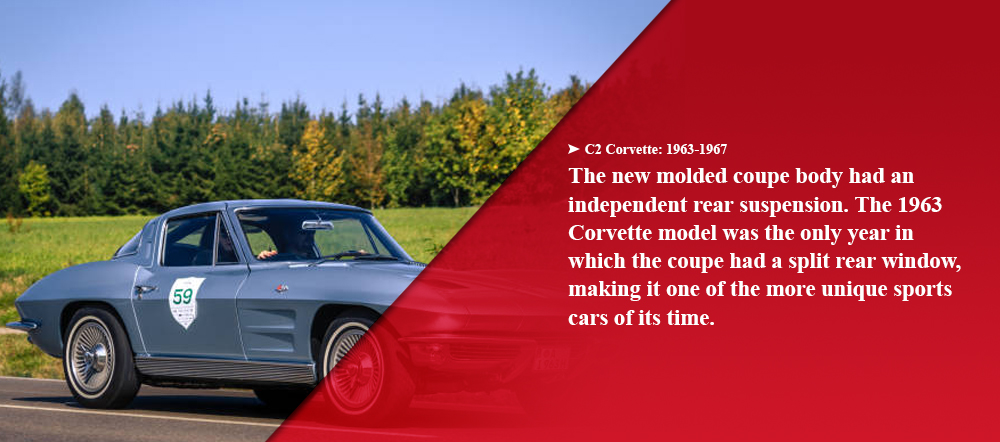
C2 Corvette: 1963-1967
The second-generation of Corvettes was the shortest-lived line of sports cars in the series, but it also underwent some massive changes, including a name change to Sting Ray.
Some features carried over from the C1, like the fiberglass body panels and 250 HP, 5.4-liter V8 engine. However, you always had the choice to upgrade to a higher horsepower that topped off at 360.
The new molded coupe body had an independent rear suspension. The 1963 Corvette model was the only year in which the coupe had a split rear window, making it one of the more unique sports cars of its time. The C2 also became the first to have the Z06 racing package option. Chevy ended up taking the Z06s and running them in various sports car series.
The Regular Production Order Z06 had the following:
- Bigger shock absorbers
- Dual master cylinder
- Larger front anti-roll bar
- Power drum brakes
- Vacuum brake system
With the addition of the Z06 engines, they were compatible only with the most powerful Corvette engine at the time, which was the 360 HP V8, with a four-speed manual transmission.
In 1965, the C2 also gained standard four-wheel disc brakes instead of the drum brake systems. Along with this year’s brake improvements, the Corvette adopted a big-block, 6.5-liter V8 engine that put out 425 HP.
In 1967, the L88 engine made an appearance. Although its specs read 435 HP, the real output of the engine was between 540 and 580 HP. Chevy produced only 20 L88 engines for the final year of the second-generation Corvettes.
The two-door coupe and convertible models pushed toward a new style, and they started developing higher-performance variants in the second generation.
The average C2 Corvette price ranges are as follows:
- 1963: $88,590
- 1964: $69,172
- 1965: $68,791
- 1966: $81,659
- 1967: $106,040
Some 1967 C2s are pricier than others from the second generation depending on various features. The most desirable of those features was the L88 engine, which makes it more sought-after because only 20 were made.
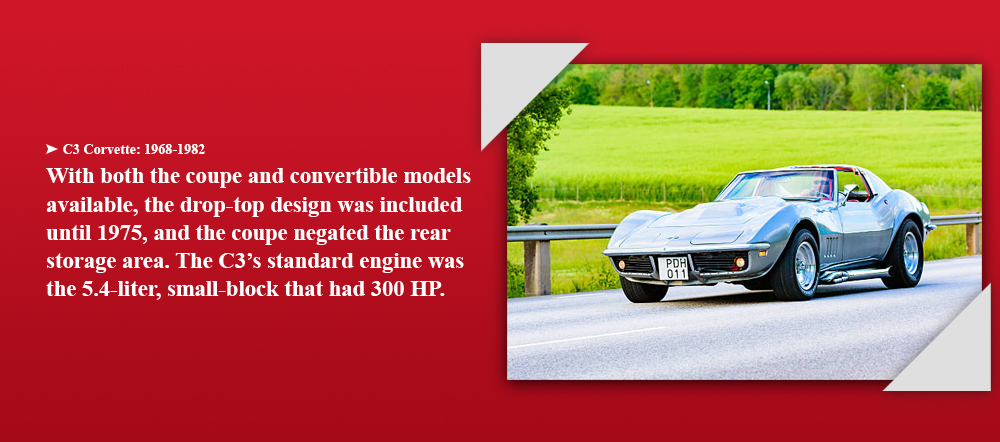
C3 Corvette: 1968-1982
By the third generation of the Chevy Corvette, the sports car went by the name of Stingray — now one word. For many, this model is the epitome of what a “true” Corvette looks like.
From the previous C2 model, it kept the engine and chassis but upgraded its body panels to have sheet metal. The C3 was also the first to pull off the T-top design and was inspired by the Marko Shark II car.
With both the coupe and convertible models available, the drop-top design was included until 1975, and the coupe negated the rear storage area. The C3’s standard engine was the 5.4-liter, small-block that had 300 HP. The V8 came with a three-speed manual transmission. There was also a four-speed manual or three-speed automatic gearbox available. The L88 engines could also upgrade to more power between 390 and 430 HP.
In 1969, another racing upgrade made an appearance called the ZR-1. The factory-installed package came with advancements, such as:
- A better four-speed gearbox
- Aluminum radiator
- Anti-roll bars
- Improved brakes
- Specific ZR-1 shocks
- Springs
However, it didn’t come with many other options, like power windows, AC, power steering or a sound system.
A few years later, Chevy had to start complying with the federal safety standards, so in 1973, they engineered a new bumper cover. Unfortunately, the C3 Corvette also saw a loss of power this year. The standard Corvette was only hitting 190 HP, and if you opted for more powerful options, you’d only hit about 275 HP.
In 1974, the addition of a rear bumper colored the same as the body was on the production line. One year later, Chevy pulled the big-block engine and worked on the sports car’s convertible style, which was cheaper than the coupe. They also added catalytic converters, while the horsepower dropped to 165 in the V8 standard.
The C3 Chevy Corvette was named the fastest car in America in 1967 after running up against the Ford Mustang Cobra, Chevy Silverado C-10, Dodge Dart Sport and Pontiac Firebird Trans Am. A new fastback rear end made an appearance in 1978 to celebrate the Corvette’s 25th anniversary, which was also the same year the third-generation sports car paced the Indy 500.
Chevy came up with the most powerful engine for the generation with 225 HP in 1980. They also upped the C3’s design to include a fresh bumper, integrated rear spoilers and a new hood. Several standard components of the 1980 Corvette included:
- Air conditioning
- Power Windows
- Telescoping and tilting steering wheel options
When looking at C3 Corvette price ranges, they average about the same price when you split the generation in half, with one exception:
- 1968: $45,346
- 1969: $51,198
- 1970: $44,429
- 1971: $41,908
- 1972: $35,494
- 1973: $23,360
- 1974: $21,926
- 1975: $18,751
- 1976: $15,429
- 1977: $16,681
- 1978: $20,955
- 1979: $14,973
- 1980: $16,972
- 1981: $16,569
- 1982: $15,524
We can assume the highest-priced Corvette from 1969 is thanks to its ZR-1 racing package. In the following years, the Corvettes experienced a decrease in power because of emissions standards, resulting in lower prices. In 1978, you can see a quick peak in pricing from Chevy’s specialty Corvette to celebrate its 25th anniversary.
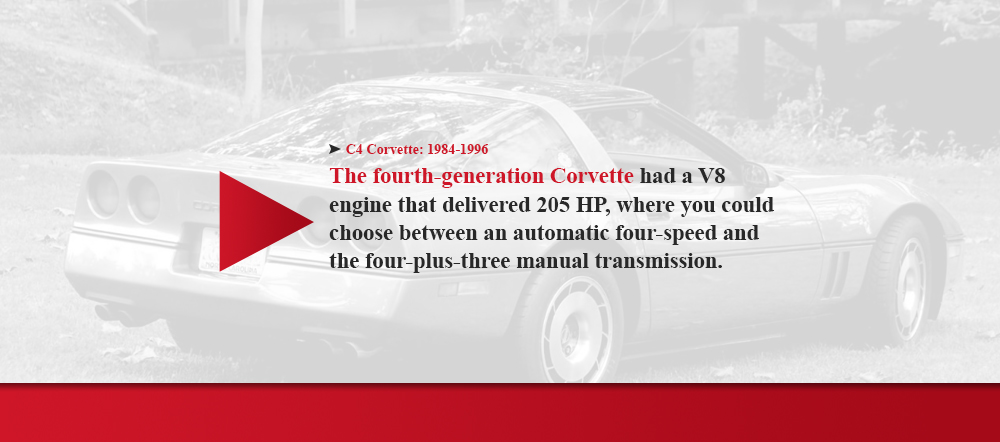
C4 Corvette: 1984-1996
A new Corvette was scheduled to debut in 1983, but because of quality concerns and delayed parts, Chevy skipped the year and released the new generation in 1984.
About thirty years after its initial debut, the Corvette underwent another transformation with a completely new build and look from the ground up, including:
- Better handling
- Digital gauge cluster
- Lower center of gravity
- More ground clearance
- New chassis
- Sleek design
The fourth-generation Corvette had a V8 engine that delivered 205 HP, where you could choose between an automatic four-speed and the four-plus-three manual transmission. The latter choice offered an overdrive for the second, third and fourth gears.
In 1986, the convertible style made a comeback to the Corvette lineup, and it also paced the Indianapolis 500. At this time, emissions standards were once again becoming stricter, so the horsepower of the C4 wasn’t through the roof yet.
Chevy built 84 Corvette ZR-1 models in 1989 but didn’t sell them to the public until 1990 through 1995. The ZR-1 Corvettes had a dual-overhead-cam V8 engine with 5.7 liters. The engine showed off an impressive 375 HP, along with a ZF-built, six-speed manual gearbox. It featured 11-inch rear wheels and had specific doors and rear body panels. Also referred to as the “King of the Hill,” the ZR-1 had a Bilstein suspension.
In 1991, Chevy designed new rear and front fascias for the Corvette. They also went for a more modern look with the inclusion of side louvers. In 1992, the standard lineup of Corvettes showed off 300 HP from the small-block V8s under the hood.
Also known as the LT1, the new V8 engine gained 50 more units of horsepower compared to the prior engine and sported 330 lb.-ft. of torque. Traction control also became standard on all Corvette models.
1992 also marked the one-millionth Corvette that made its way off the production line, making it another coveted design. It featured a white exterior with a fierce red interior.
Another popular C4 model was the Grand Sport. In 1996, Chevy manufactured 1,000 Grand Sport cars that featured 330 HP. The GS sports car came with the iconic Admiral Blue exterior with a white stripe down the center and dual red hash marks on the front left fender — yet another desirable fourth-generation creation. Chevy offered it to consumers as a convertible and coupe, but the coupe didn’t have flared fenders.
The final year of the C4’s production was the only year to have the LT4 engine.
Average C4 Corvette price ranges from 1984-1996 are:
- 1984: $7,547
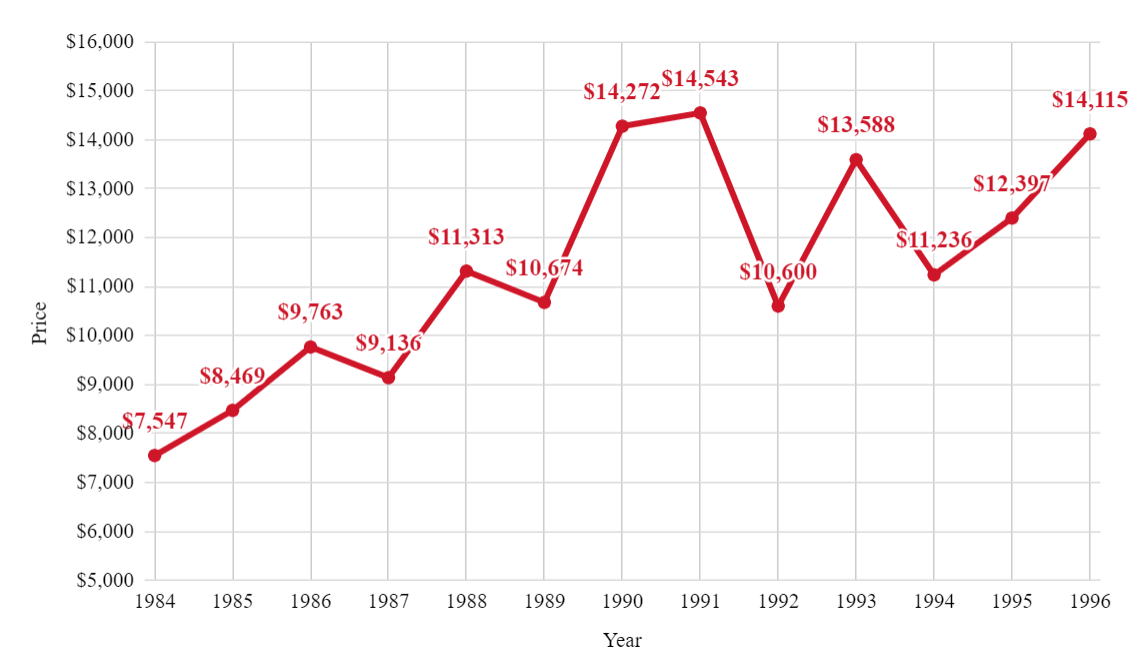
- 1985: $8,469
- 1986: $9,763
- 1987: $9,136
- 1988: $11,313
- 1989: $10,674
- 1990: $14,272
- 1991: $14,543
- 1992: $10,600
- 1993: $13,588
- 1994: $11,236
- 1995: $12,397
- 1996: $14,115
If you’re looking for the best value Corvette model, 1984-1987 and 1989 fourth-generation Corvettes are some of the most affordable Corvette models. In some cases, you can find a 1984 and 1986 Corvette for under $6,000. When the 1990 came about, the price increased because of Chevy’s ZR-1. Another popular Corvette is the limited Grand Sport with an eye-catching blue exterior.
C5 Corvette: 1997-2004
For the fifth-generation Corvettes, Chevy decided to engineer a fresh sports car with a new LS1 engine, replacing the LT1 and LT4. The 5.7-liter engine revved up to 345 HP. Drivers could choose between a four-speed automatic or six-speed manual transmission. Compared to previous generations, the C5’s transmission was now at the rear of the car near the differential, giving the sports car a 50/50 weight distribution.
The Chevy also sported a longer wheelbase by eight inches, a wider front track by about four inches and a fuller rear track by about three inches. The extra room gave riders additional space while also making the sports car more stable than before. It was even lighter by about 80 pounds, which was a massive feat.
The C5 also had a hydroformed frame, which means it was built via a tubular piece of metal that engineers shaped into the Corvette style using dies and pressurized liquid. The new structure gave the Corvette a more rigid look.
In 1998, the convertible style made another comeback, and one year later, the fixed-roof made an appearance on the Corvette coupe. The fixed-roof had a similar body style of the targa-topped hatchback and the convertible versions combined. It was also 12 percent stiffer than the targa model and the least expensive model at the time. In 1999, Chevy was offering three fifth-generation models: targa-top, fixed-roof coupe and convertible.
By 2001, the Z06 Corvette started hitting the pavement again. It carried the Z06 name from the 1963 Corvette series that was a renowned racing package. Except now, it had added power of 385 HP with a six-speed manual. Chevy trimmed weight off the car by installing thinner rear and front glass panels and implementing titanium mufflers.
With the C5 Corvette’s advanced power-to-weight ratio, the sports car could now climb to 60 mph in 4.3 seconds. It also showed off larger tires, a refined suspension system and cooling ducts for the brakes. One year later, the fifth-generation Corvette got another engine upgrade to the 405 HP Z06 engine.
The 2001 Corvette was marketed as being “race-ready.”
On average, C5 Corvette price ranges are within a particular budget without straying too high. Here is a list of Corvette model prices for the fifth generation market:
- 1997: $12,090
- 1998: $13,910
- 1999: $14,252
- 2000: $14,567
- 2001: $16,209
- 2002: $17,337
- 2003: $18,517
- 2004: $17,550
If you’re searching for a C5 on the lower end, some of the earlier versions are where you’d want to begin. The starting price for the 1999 Corvette was $45,579. Today, you can cut that price in half, then take off about six to eight thousand more dollars.
Keep in mind — any Chevy Corvette you’re after will have a price tag that depends on many factors aside from its year.
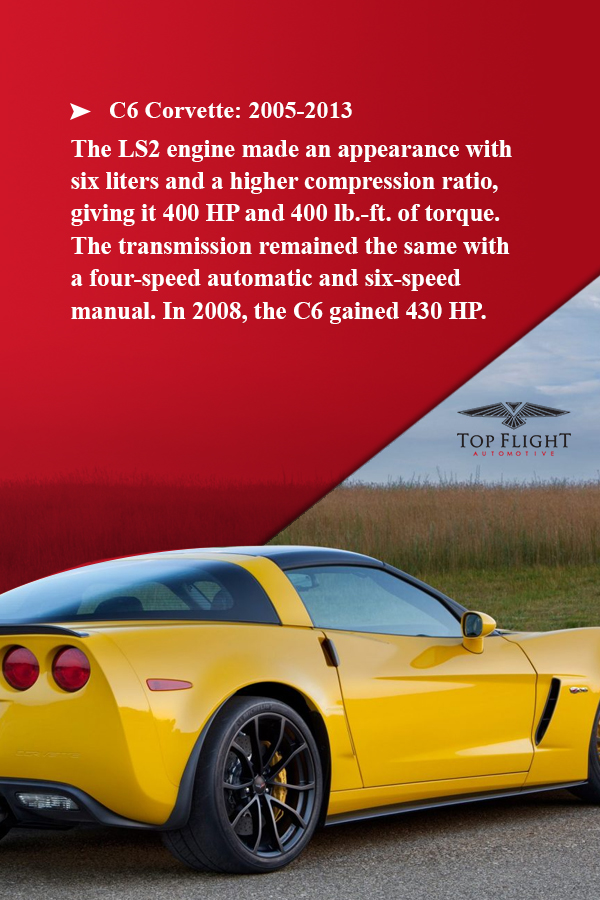
C6 Corvette: 2005-2013
A year before the sixth-generation of Corvettes hit the road, Chevy unveiled its newest addition at the 2004 Detroit Auto Show.
What caught people by surprise was that Chevy got rid of the classic hidden headlights, which was a staple of previous Corvette models. The exposed front lamps were a massive change for the first time in four decades — making it one of the most distinctive generations.
The sixth-generation Corvette was also the first time a navigation system was available to drivers. Even the convertibles were accessorized with the power-top option for the first time since 1962. While the sports car came up shorter in length, it sported 1.2 inches more on the wheelbase.
The LS2 engine made an appearance with six liters and a higher compression ratio, giving it 400 HP and 400 lb.-ft. of torque. The transmission remained the same with a four-speed automatic and six-speed manual. In 2008, the C6 gained 430 HP.
Another exciting turn in the sixth-generation Corvette was the reappearance of the Z06 in 2006. Except now, it had a light aluminum frame as opposed to steel, plus a coupe-style with a fixed roof.
The new Z06 had the latest LS7 engine that produced a whopping 505 HP and 470 lb.-ft. of torque. The extra power of the C6 allowed the Corvette to hit 60 mph in 3.4 seconds. Other features included:
- Air inlet in the front bumper
- Brake cooling ducts
- Carbon fiber front fenders
- Wider rear fenders
Chevy again brought a blast from the past up in 2009 with the ZR-1. Known as the “Blue Devil,” it was back in the picture after several decades, having a supercharger on the overhead valve compared to the previous version’s twin-cam. The new ZR-1 reached a top horsepower of 638, allowing the sports car to accelerate up to 205 mph.
The Grand Sport was reintroduced in 2010 as Chevy paired it with the chassis components of the Z06. In 2013, Chevy celebrated the Corvette’s 60th anniversary by building the Z06 engine. They built the 505 HP engine into the Corvette drop-top model, known as the Corvette 427 convertible. It could reach 60 mph in 3.9 seconds.
From 2005 to 2013, the C6 Corvette price ranges increase with each year.
- 2005: $19,408
- 2006: $22,486
- 2007: $23,168
- 2008: $25,462
- 2009: $31,561
- 2010: $33,638
- 2011: $33,979
- 2012: $33,371
- 2013: $38,018
The 2013 sixth-generation Chevy Corvette has the highest price tag of the series because it’s a special 60th anniversary edition. If you’re looking to buy a Corvette on a budget, the initial C6s to debut will still give you an awesome restoration project without the high price. For example, most 2005 Corvettes are around $20,000.
C7 Corvette: 2014-2019
With the arrival of the seventh-generation Corvette, it’s no surprise that it came with some massive changes. Stingray returned once again, and the C7s now featured standard aluminum frames and carbon fiber hoods.
The new C7 Stingray LT1 engine boasted 455 HP with 460 lb.-ft. of torque in 2014. In addition, you had the option to advance your sports car with a performance exhaust system, allowing your engine to boost its horsepower up to 460. Drivers also had the choice between a seven-speed manual or six-speed automatic. One year after the start of the C7, Chevy created another transmission option with an eight-speed automatic.
In 2015, Chevy brought back the Z06 with higher performance levels than before. It also sported the convertible and coupe styles. The C7 Corvette had 650 HP and the same for torque. Chevy advanced its handling with added features, like:
- Limited-slip differential
- Performance Traction Management
- Standard Magnetic Ride Control dampers
In 2017, the Grand Sport model with the Z06 suspension was the base seventh-generation model. Then, in 2019, the ZR-1 topped out the seventh generation’s performance with a 755 HP, 715 lb.-ft. of torque V8 engine. It could hit 60 mph in 3.7 seconds — a long shot from the 12 seconds in 1953. You could choose between a coupe or convertible and an automatic or manual transmission style C7.
While the Corvette had an incredible amount of power, it surprisingly maintained 20 mpg on the highway. C7 Corvette price ranges include:
- 2014: $40,065
- 2015: $45,982
- 2016: $50,039
- 2017: $52,359
- 2018: $53,708
- 2019: $64,840
The price of each sports car increases throughout the generations, except for when you look at the C1 and C2 models because of their rarity. Because C7s are still on the market, you can find them at similar prices to when they were in production.
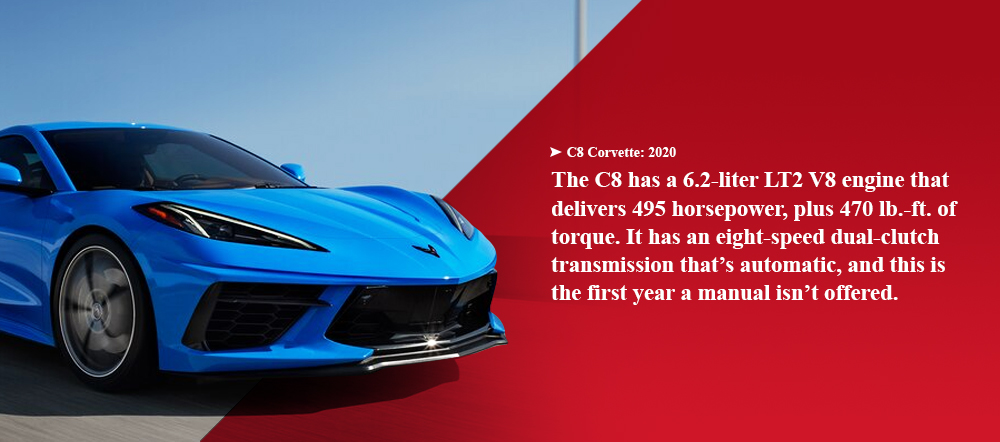
C8 Corvette: 2020
The 2020 Corvette has lived up to much of its hype as the eight-generation Chevy. It’s gone through some of the most radical changes compared to its seven other predecessors.
For starters, it’s a mid-engine Corvette that can go from 0 to 60 mph in 2.9 seconds. It also retails for a little less than $60,000 — which is remarkable for its line of performance and technology.
The C8 has a 6.2-liter LT2 V8 engine that delivers 495 horsepower, plus 470 lb.-ft. of torque. It has an eight-speed dual-clutch transmission that’s automatic, and this is the first year a manual isn’t offered. The 2020 Corvette shows off dramatic and streamlined body lines and incredible interior features unseen before in the industry. The C8 has more aerodynamic components and unseen technology.
Other crafted characteristics of the eight-generation Chevy Corvette include:
- Driver Mode Selector
- Front Lift
- Hidden door handles
- Performance Data Recorder
- Racing-inspired wheel
- Retractable hardtop
- Visible LT2 V8 through the rear hatch window
C8 Corvette price ranges are pretty straightforward and depend on how many extras you want to add on. The starting price for a 2020 Corvette Stingray coupe is $59,995, while the starting tag for a convertible is $67,495.
Restoration Parts for Any Corvette Generation
Whether you’ve budgeted for a C4, C6 or another Chevy Corvette, Top Flight Automotive has everything you need for restorations and repairs. We are the number one manufacturer and supplier of Corvette accessories, parts, wheels and interiors. As the largest manufacturer of Corvette parts, our solutions are engineered to meet or exceed the original components of your Corvette. Top Flight Automotive online retail is available 24/7, and we also offer a tiered loyalty program.
Shop Our Online Store By Corvette Generation:
Browse our extensive inventory of Corvette parts or reach out to our experienced sales representatives for more information.



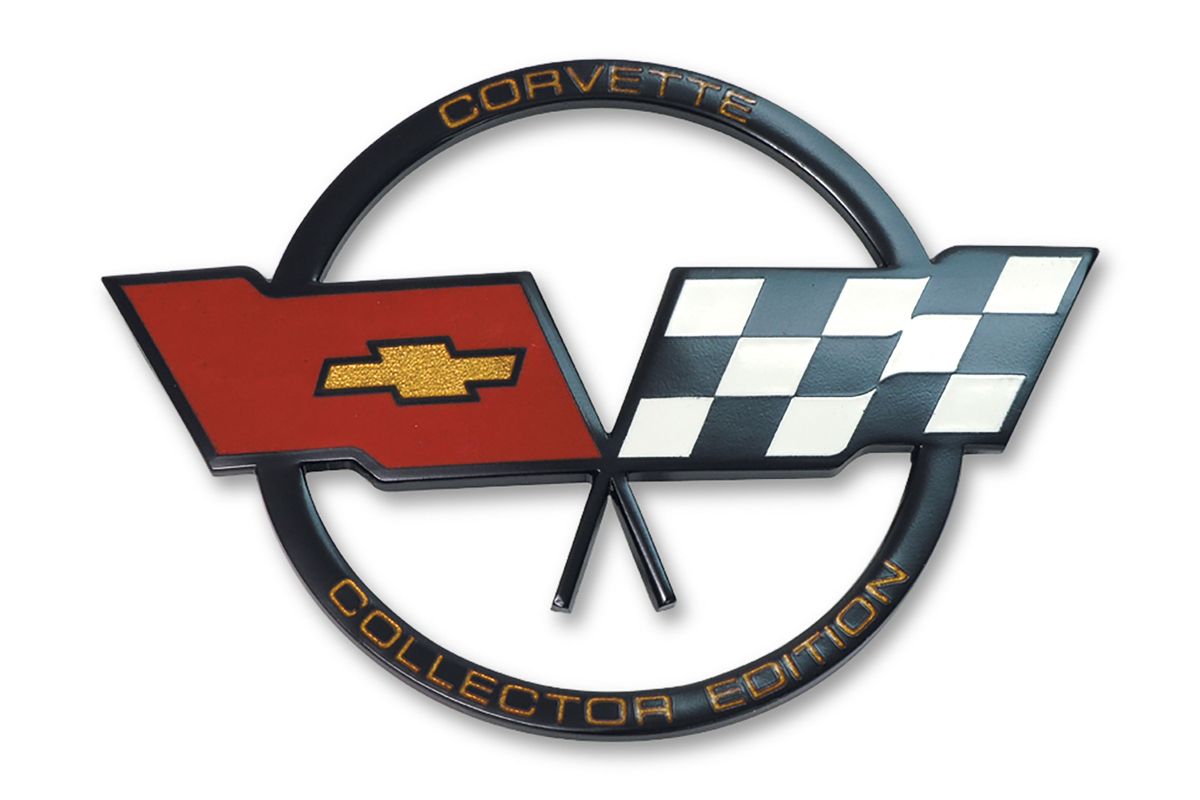
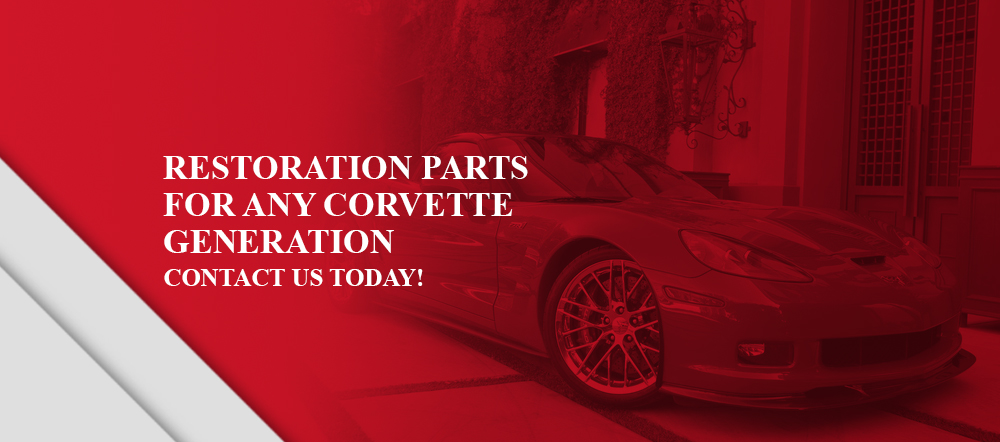







August 15th, 2022 at 6:40 am (#)
Very cool offerings! Nice to have a source for what ever Covette you choose!